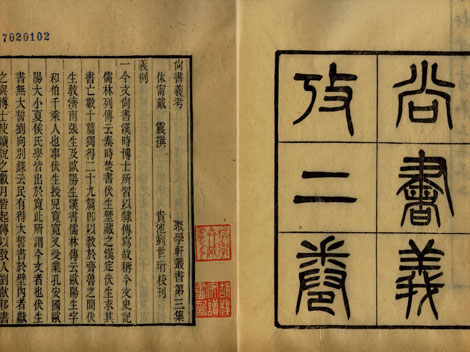
Originally called Shu (Book), The Classic of History got the name in the Han Dynasty, meaning a book of previous generations. It is China's earliest compilation of documentary records related to events in ancient history of China. After the Han Dynasty, The Classic of History became one of the most important Confucian classics, thus it's also called Shujing (Classic of Documents).
The Classic of History retains some important historical material of the Shang and Zhou Dynasties, especially the Western Zhou Dynasty. The main content of the book is the ancient imperial proclamations and conversations between emperors and ministers, mirroring the astronomy, geography, philosophic thinking, education, criminal law and institutional systems etc of that historical period. The book is a precious material for the understanding of ancient Chinese society.
Written in prose, The Classic of History is arranged in chronological order. It consists of 100 articles in four parts: The Document of Yu (Shun), The Document of Xia (Dynasty), The Document of Shang (Dynasty) and The Document of Zhou (Dynasty). The book is in four writing forms: 1) "codes" - the documentation of law codes and statutes; 2) "written admonitions" - the conversations between emperors and ministers and those between ministers, as well as prayers at sacrificial rituals; 3) "pledges" - the pledges made by emperors and vassals; 4) "mandates" - the imperial mandates emperors made when appointing officials or rewarding vassals.
Since the Han Dynasty, The Classic of History has been regarded as a classic on feudal Chinese politics and philosophy. It served as both a textbook for the emperors and an authoritative and classic code that children from noble families and scholar-bureaucrats must follow. The Classic of History had a great impact in Chinese history. Although the content of the diverse chapters of this book discribes events from the time of the Yellow Emperor(黄帝), the taming of the floods by Yu the Great(大禹) and speeches of kings and ministers of the Xia(夏) and the Shang(商) dynasties, it is not older than from Western Zhou times (Xizhou, 西周). A great part of the chapters were even compiled during later periods.
In the late second century BC, a so-called Old Text (guwen, 古文) was discovered in the walls of Confucius' old house. 58 of original hundred chapters, said to be arranged by Confucius himself, survived. The scholar Kong Anguo(孔安国) wrote a preface to the fragments of the 100 chapter book (Baipian Shangshu, 百篇尚书). 28 of these chapters were still extant in Early Han(汉) times but written in modern characters, thus called "New Text" (jinwen, 今文). When the First Emperor of Qin(秦始皇) ordered to burn all non-Legist texts, a man named Fu Sheng(伏生) had succeeded in hiding and rescuing these chapters.
The chapters are chronologically arranged and are divided into five different types of speeches: mo(谟) consultations, xun(训) instructions, gao(诰) announcements, shi(誓) declarations and ming(命) commands. The 28 New Text chapters were composed during the late Warring States period(战国时代) and are thus very far from the events they purport to talk about. Nevertheless, the chapters reporting the events of King Cheng's(周成王) reign seem to have original parts. Many citations of the Shangshu in other texts like Mengzi(孟子) can not be found in the fragments still existing. The traditional English translation is that of James Legge.
Compilation
The book consists of 58 chapters (including eight subsections), of which 33 are generally considered authentic works of the 6th century BC. The first five chapters of the book purport to preserve the sayings and recall the deeds of such illustrious emperors as Yao and Shun, who reigned during legendary age; the next 4 are devoted to the Xia Dynasty, the historicity of which has not been definitively established; the next 17 chapters deal with the Shang Dynasty and its collapse. The blame for this is placed on the last Shang ruler, who is described as oppressive, murderous, extravagant, and lustful. The final 32 chapters cover the Zhou Dynasty until the reign of Duke Mu of Qin. It contains examples of early Chinese prose, and is generally considered one of the Five Classics. The Shujing is possibly the earliest narrative of China, and may predate the Historiai of Herodotus as a history by a century. Many citations of the Shangshu can be found in the bamboo slips texts from the tombs of Guodian, in Hubei, dated to the 300 BC. In July 2008, Zhao Weiguo, an alumnus of Tsinghua University donated a collection of 2100 bamboo slips to his alma mater after obtaining them through auction in Hong Kong. The previous owner and the slips' whereabouts have not been revealed. In the collection, the Shangshu is one of the historical books. According to expert Li Xueqin, the collection dates to the Warring States Period from Hubei, the homeland of Chu.
We recommend:
